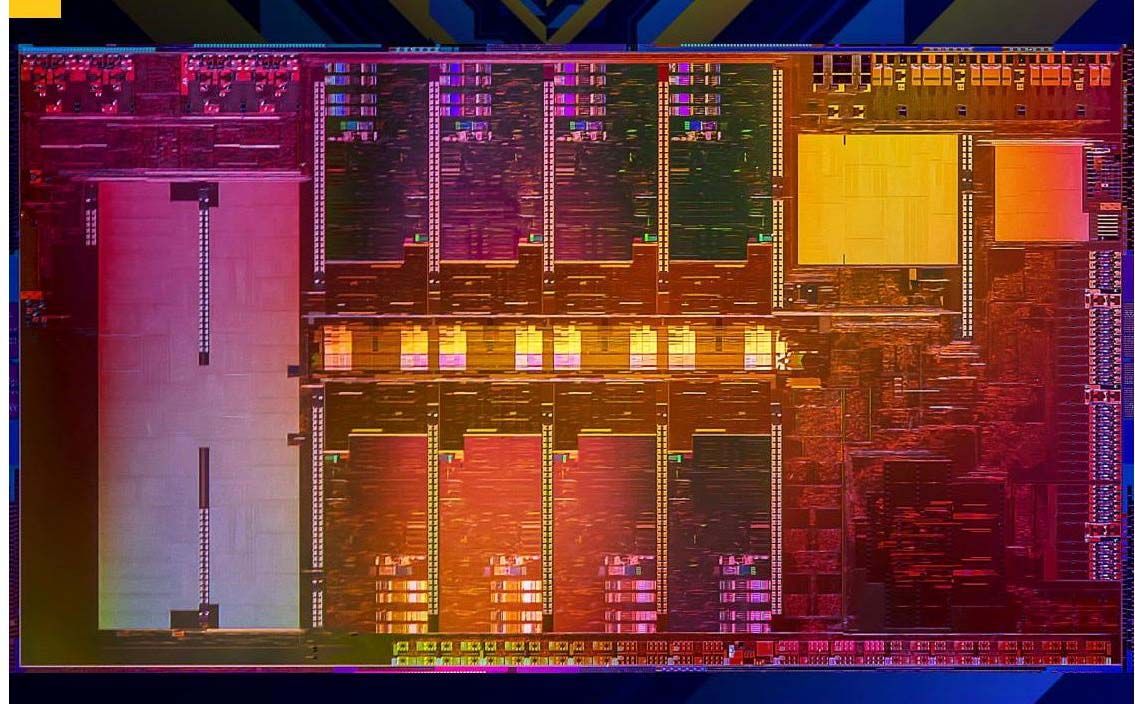Because the specifications of the new models leaked last week and the addition is only minimal, you probably won’t be surprised by the news. It is true that the default TDP is 45 watts, while for the top model it can be increased to 65W and for all others it can be reduced to 35W. Up to 5.0 GHz can reach innovations regardless of temperature (quad-core Core i7-11375H conditioned running at 5.0 GHz with a temperature below 60 ° C).
| Core | core fibers. |
rate | L3 | GPU (ME) |
GPU GHz |
TDP | price |
|---|---|---|---|---|---|---|---|
| i9-11980HK | 8 / 16 | 2,6 / 5,0 GHz | 24MB | 32 | 1,45 | 45W+ | $583 |
| i9-11950H | 8 / 16 | 2,6 / 5,0 GHz | 24MB | 32 | 1,45 | 45W | $556 |
| i9-11900H | 8 / 16 | 2,5 / 4,9 GHz | 24MB | 32 | 1,45 | 45W | $546 |
| i7-11850H | 8 / 16 | 2,5 / 4,8 GHz | 24MB | 32 | 1,45 | 45W | $395 |
| i7-11800H | 8 / 16 | 2,3 / 4,6 GHz | 24MB | 32 | 1,45 | 45W | $395 |
| i5-11500H | 6 / 12 | 2,9 / 4,6 GHz | 12MB | 32 | 1,45 | 45W | $250 |
| i5-11400H | 6 / 12 | 2,7 / 4,5 GHz | 12MB | 32 | 1,45 | 45W | $250 |
| i5-11260H | 6 / 12 | 2,6 / 4,4 GHz | 12MB | 32 | 1,40 | 45W | $250 |
| i7-11375H | 4 / 8 | 3,3 / 5,0 GHz | 12MB | 96 | 1,35 | (28) 35W | $482 |
| i7-11370H | 4 / 8 | 3,3 / 4,8 GHz | 12MB | 96 | 1,35 | (28) 35W | $426 |
| i7-1185G7 | 4 / 8 | 3,0 / 4,8 GHz | 12MB | 96 | 1,35 | (12) 28 W | $426 |
| i7-1180G7 | 4 / 8 | 2,2 / 4,6 GHz | 12MB | 96 | 1,10 | (7) 15 W | $426 |
| i7-1068G7 | 4 / 8 | 2,3 / 4,1 GHz | 8 MB | 64 | 1,10 | 28 W | ? |
| i7-1165G7 | 4 / 8 | 2,8 / 4,7 GHz | 12MB | 96 | 1,30 | (12) 28 W | $426 |
| i7-1065G7 | 4 / 8 | 1,3 / 3,9 GHz | 8 MB | 64 | 1,10 | 15 (25) W | $426 |
| i5-1145G7 | 4 / 8 | 2,6 / 4,4 GHz | 8 MB | 80 | 1,30 | (12) 28 W | $309 |
| i5-1140G7 | 4 / 8 | 1,8 / 4,2 GHz | 8 MB | 80 | 1,10 | (7) 15 W | $309 |
| i5-11300H | 4 / 8 | 3,1 / 4,4 GHz | 8 MB | 80 | 1,30 | (28) 35 W | $309 |
| i5-1135G7 | 4 / 8 | 2,4 / 4,2 GHz | 8 MB | 80 | 1,30 | (12) 28 W | $309 |
| i5-1035G7 | 4 / 8 | 1,2 / 3,7 GHz | 6 MB | 64 | 1,05 | 15 (25) W | $320 |
| i5-1035G4 | 4 / 8 | 1,1 / 3,7 GHz | 6 MB | 48 | 1,05 | 15 (25) W |
$309 |
| i5-1035G1 | 4 / 8 | 1,0 / 3,6 GHz | 6 MB | 32 | 1,05 | 15 (25) W | $297 |
| i3-1125G4 | 4 / 8 | 2,0 / 3,7 GHz | 8 MB | 48 | 1,25 | (12) 28 W | $281 |
| i3-1115G4 | 2 / 4 | 3,0 / 4,1 GHz | 6 MB | 48 | 1,25 | (12) 28W | $281 |
| i3-1005G1 | 2 / 4 | 1,2 / 3,4 GHz | 4 MB | 32 | 0,90 | 15 (25) W |
$281 |
| i7-1160G7 | 4 / 8 | 1,2 / 4,4 GHz | 12MB | 96 | 1,20 | (7) 15 W | $426 |
| i7-1060G7 | 4 / 8 | 1,0 / 3,8 GHz | 8 MB | 64 | 1,10 | 9 (12) W |
? |
| i5-1130G7 | 4 / 8 | 1,1 / 4,0 GHz | 8 MB | 80 | 1,10 | (7) 15 W | $309 |
| i5-1030G7 | 4 / 8 | 0,8 / 3,5 GHz | 6 MB | 64 | 1,05 | 9 (12) W | ? |
| i5-1030G4 | 4 / 8 | 0,7 / 3,5 GHz | 6 MB | 48 | 1,05 | 9 (12) W | ? |
| i3-1120G4 | 4 / 8 | 1,1 / 3,5 GHz | 8 MB | 48 | 1,10 | (7) 15 W | $281 |
| i3-1110G4 | 2 / 4 | 1,8 / 3,9 GHz | 6 MB | 48 | 1,10 | (7) 15 W | $281 |
| i3-1000G4 | 2 / 4 | 1,1 / 3,2 GHz | 4 MB | 48 | 0,90 | 9 (12) W | ? |
| i3-1000G1 | 2 / 4 | 1,1 / 3,2 GHz | 4 MB | 32 | 0,90 | 9 (12) W | ? |
Prices can be evaluated very positively. This is a consequence of the fact that AMD with mobile APUs Cezanne Intel has overtaken and it must do more to attract both manufacturers and customers. He announced that he was doing well by announcing 1 million distributed processors Tiger Lake-Hthat will be available in a range of 80 laptop models. Despite the fact that Intel has so many of them, no pieces of reviews were delivered to the media on the occasion of the release. According to the editor of the Anandtech website, laptops should appear in reviews in a month.
The only performance data that customers can judge the next generation of processors at this time (and next month) is from Intel. Of course, he cared about them, so we learn that the top model, the Core i9-11980HK, achieves + 20% higher gaming performance than the competing Ryzen 9 5900HX:
It is interesting how some newsrooms reacted to these results. Anandtech slides performance charts into an release article Tiger Lake-H Intel included testing the Core i9-11980HK in 65W mode compared to the Ryzen 9 5900HX in 45W mode. However, it seems that the difference of 20 watts / half higher TDP does not give us the whole picture of the situation. The editors of the Tom’sHardware website have found that the Core i9-11980HK in the basic (45W) mode has the PL2 limit (ie realistically achievable consumption) increased to 107 watts and in the 65W mode to 135 watts. The processor can run virtually without power consumption on any boost you can think of.
Tiger Lake A “divider” between the memory controller and the memories, which is somewhat reminiscent of the mode used Zen 3. Either the controller and the memory can run 1: 1, which corresponds to the use of DDR4-2933 and is advantageous for games, or the controller and the memory can run 1: 2, which corresponds to the use of DDR4-3200 and is advantageous for multi-core load. Surprisingly, LPDDR4 (X) support is u Tiger Lake-H removed and Intel no longer talks about the originally announced LPDDR5.
In this context, it is worth noting that Tiger Lake-H supports Thunderbolt 4, but related USB 4.0 – although Intel also talked about it at the beginning of the year (see e.g. Tom’sHardware) – never. Anandtech pointed out that even in the case of USB 3.0, it does not specify whether it is USB 3.2 Gen 1 or Gen 2.
Tiger Lake-H has 20 PCIe 4.0 lines that can be used in combinations:
- × 16 for GPU, × 4 for storage
- × 8 / × 8 for GPU, × 4 for storage
- × 8 for GPU, × 4 / × 4 / × 4 for storage
Tiger Lake-H is therefore interesting as the first 10nm octave from Intel, which is also in terms of IPC similar to the competitor Zen 3. After a completely exaggerated quad-core price Tiger Lake-H35 set Intel far more reasonable prices. While a quad-core up to 4.8GHz Core i7-11370H cost $ 426, for eightcore up to 4.8GHz Core i7-11850H charges $ 395. Twice as many cores of the same architecture with the same boost for even $ 31 less? That already looks interesting.
Equipment can be disappointing. Although it is not bad and includes, for example, PCIe 4.0, after the promises of LPDDR5 (when even LPDDR4 (X) is not really supported and after the promises of USB 4.0 (when it is not really certain whether USB 3.2 Gen 2 is supported), the equipment is disappointing There is Thunderbolt 4, but those who do not use it for that already Tiger Lake-H it does not have other unique features (such as USB 4.0 or LPDDR5).
How good Tiger Lake-H It may or may not eventually show reviews. From the release of the previous two 10nm generations of mobile processors, we know that Intel tends to select very good results for the charts and does not deal much with the fact that the compared products have different TDPs (and completely different consumption) or fall into different prices. It therefore makes sense to give weight to published numbers only when they are confirmed by third-party tests.
There is some caution on the part of notebook manufacturers: While AMD with the Ryzen 3000 mobile supplied processors for ~ 100 notebook models and with the Ryzen 5000 for more than 150 notebook models, Intel in context Tiger Lake-H talks about 80 models. Although it is not possible to directly compare the numbers of AMD and Intel (the first refers to the whole generation, the second to the powerful series of the given generation), it can still be said that it is a weaker value for Intel’s conditions.
Comet Lake-H / 10th generation H series
Compared to 14nm Comet Lake-H, for which Intel boasted more than 100 models of high-performance laptops, is a 20% intergenerational decline.
–






